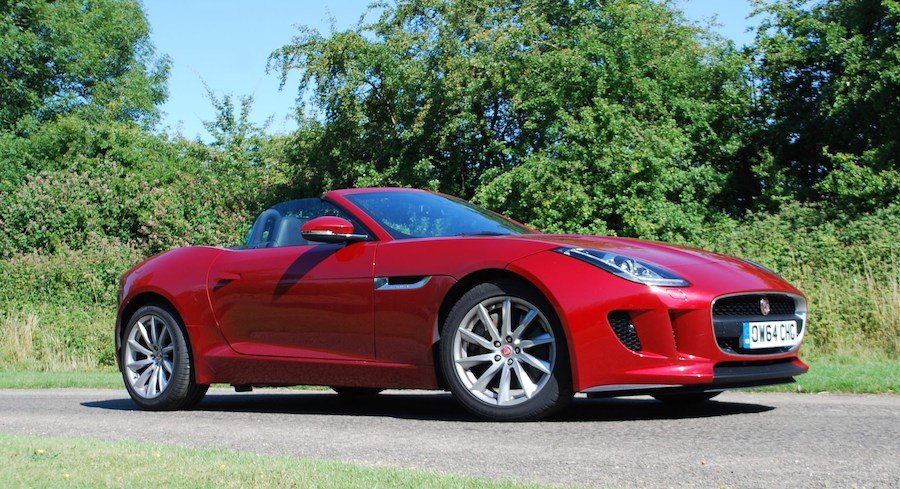Nearly new buying guide: Jaguar F-Type

Good Lord, it has aged well, this Jaguar F-Type.
It has been through a facelift or two, of course, but even the early cars still look fab, arguably even more so than the later ones.
The convertible has been around since 2013 and it was followed a year later by the coupé. The latter is the more practical car on account of a boot that can house a couple of sets of golf clubs rather than just a bag of tees and a glove.
Under that handsome bonnet is a good range of hot engines, too, and there’s not really a weak point as far as performance goes. Even the entry-level F-Type has a powerful 2.0-litre four-cylinder engine that will propel the car to a top speed of 155mph.
The 335bhp supercharged V6 will get you from 0-62mph in 5.1sec. You will find a few examples of this particular F-Type with a manual gearbox, but because the shift is a little unsatisfying, our advice is to go for the excellent automatic instead.
Opting for the V6 S will get you 375bhp and from 0-62mph in 4.8sec (as well as adaptive dampers for a smoother, if still firm, ride), while the 542bhp V8 R will cover the same sprint in just 4.0sec, making it a true supercar contender.
Befitting its extra performance, the F-Type R also comes with a more advanced vehicle dynamics system and firmer suspension, plus uprated carbon-ceramic brakes. You will need all this because the rear-wheel-drive V8 F-Type is a lively machine. It’s perhaps no surprise that Jaguar made four-wheel drive standard on the V8 from 2015, as well as an option on the V6 S.
If the F-Type R still leaves you yearning for more noise and performance, a 567bhp SVR version has been offered since early 2016 and just so happens to be the first Jaguar since the XJ220 supercar to have a top speed in excess of 200mph.
The F-Type is heavier than some of its rivals and occasionally feels it on the road, but it can still attack corners with gusto, as the steering is precise and the grip levels good. However, with so much power available, it’s easy to get things out of shape, especially in the wet.
The ride is certainly sports car firm, but it’s not overly bumpy and, as mentioned, the more powerful V6 models and above come with adaptive suspension that helps to smooth out some of the larger bumps.
The interior has room for two tall adults, helped by low-mounted sports seats and a steering wheel that adjusts electrically for reach and height, providing the kind of perfect driving position you would expect.
Keeping things up to date, a refresh in 2017 was followed by another in 2020 to reinvigorate the styling, add some new tech inside and tweak the engine line-up. To that end, the 2.0-litre four-cylinder engine became the P300 and the P450 was the supercharged 5.0-litre V8 with 444bhp. The P575 – exclusive to the F-Type R – is a version of the same V8 engine but with even more power.
Need to know
Around £25k buys you a 2014 V6. The more powerful S and the entry-level 2.0 car start at £26k. Spend £28k-£35k on 2018 and 2019 cars in good condition and £40k-£50k on 2020 models. An R is at least £33k and the SVR £55k.
In 2017, the car was facelifted, gaining Touch Pro infotainment, R-Dynamic replaced S and the 400 Sport arrived. In 2018, it got torque-vectoring, a bigger screen and new badging. A significant redesign then came for 2020.
Buyer beware
Early infotainment: The infotainment system in early F-Types wasn’t great when it was new, and today it seems positively antiquated, being slow to respond and sometimes awkward to navigate. From 2017 onwards, Jaguar’s newer system was fitted and it’s better – albeit still not the best.
Look for parking aids: The downside of sitting so low is that it’s not terribly easy to judge where the corners of the car are, so it’s worth taking the time to seek out an F-Type with front parking sensors and possibly a reversing camera, too.
Watch the differential: Some owners have found that the rear differential can leak oil due to faulty seals. If this needs to be fixed, ensure the coupling isn’t over-tightened, as this can ruin the diff completely, first signalled by unpleasant noises from the rear of the car.
Active exhaust glitch: Speaking of noise, some owners have also found the valves in Jaguar’s active exhaust system can stick open. This can require a new back box.
Cabin quirks: The rising centre air vent and pop-out door handles have also caused problems for a few owners, and it’s not unknown for the F-Type to accrue a few squeaks and rattles over time.
Top spec
S: Even the cheapest F-Types are packed with equipment, including climate control, sat-nav, rear parking sensors and a DAB radio. Choosing S trim (or R-Dynamic in later cars) adds a switchable sports exhaust, cruise control, adaptive dampers, a limited-slip differential and full leather seats.
Our pick
3.0 V6 S: Based on its used cost and performance, the earlier V6 S represents the range’s sweet spot, particularly if you find one with a few choice upgrades such as front parking sensors and Performance seats.
Wild card
5.0 V8 R AWD: All the beauty with that immense power to match – and the bonus of four-wheel drive on the later ones for a bit of added stability. The SVR is more powerful still but will set you back a lot more.
